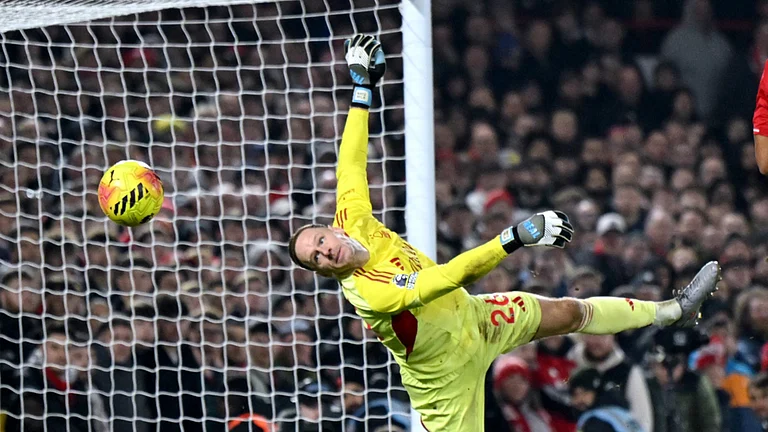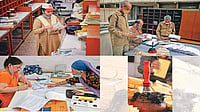The nation wants to know the truth about TRPs. As TV channels got embroiled in the viewership scandal, Mumbai Police interrogated CEOs of media firms and evidence cropped up daily, viewers were caught in another media blizzard. The new allegation: channels paid money to families, which were part of the TRP survey group, to manipulate and increase their viewership. TRPs (Television Rating Points) quantitatively measure the popularity of broadcast channels.
In this media circus of turbulence, which rocked the country after the vitriolic “trial by media” in the Rhea Chakraborty-SSR case, experts expressed doubts about the Indian Readership Survey (IRS). Outlook spoke to dozens of senior managers from media and advertising firms to investigate the veracity of the survey. Like what TRPs do for channels, the IRS gauges the ‘reach’ (not the circulation, as a copy of a newspaper can be read by several people) of print media publications.
Coincidentally, many entities and personalities figure in both the TRP scam and IRS controversy. A few media conglomerates own print publications, news channels, and websites. Their representatives perform crucial roles in both Media Research Users Council India (MRUCI), which conducts IRS, and Broadcast Audience Research Council (BARC) India, which measures TRPs. (MRUCI and BARC are joint industry companies. Outlook is a member of MRUCI, but its representatives do not hold any posts in the governing council or other internal committees. MRUCI refused to answer questions that were emailed by Outlook.)
What’s scathing, and illuminating, is that MRUCI accepts that IRS is prone to criminalisation. The entity’s 2017-18 annual report noted, “However, the biggest and more worrisome reason is the continuing efforts of malicious elements to influence the data collection process. And this is a far harder battle, which we have to fight. It is in the best interests of the industry that perpetrators of such heinous crimes desist from doing so, and appreciate that the measurement system works for all only when there is a fair playing field.”
The report added, “We have actively engaged with the Indian Newspaper Society (INS) to seek their help in addressing this malaise, and we are happy to state that the INS has agreed to step in and provide the necessary support. We seriously hope that this is a deterrent that will prove to be the game changer, and help us win this battle.”
But the illegalities continued. The 2018-19 annual report elaborated, “We have previously touched upon the seriousness of the issue of external influences trying to disrupt the fieldwork and the data collection process. To actively work towards a long term deterrent to this malaise, the Indian Newspaper Society (INS), along with other key industry bodies, i.e. Audit Bureau of Circulation (ABC) and Advertising Agencies Association of India (AAAI) have agreed to take a more proactive approach in fighting this in tandem with MRUC(I)….”

Who is reading what?.
To inculcate fairness and transparency, the MRUCI appointed an internal disciplinary committee, which was guided by an external steering committee, which included representatives of INS and AAAI. The INS separately set up the IRS Vigilance Team to investigate fraudulent cases, and submit independent reports. “We intend to deal very strongly with offenders, if any,” said the 2018-19 report. The problems continued, which was hinted in the 2019-20 annual report.
“The (Governing) Council (of MRUCI) continues to make every effort… to ensure that a fair and representative study is delivered to its subscribers. We earnestly request the industry members to do their own bit to dissuade any external influences,” the 2019-20 report said. Thus, over the years, MRUCI acknowledged malpractices in data collection. This was despite the fact that the survey’s field work was handled by Nielsen, a well-known firm, between 2013 and 2020.
Industry insiders explain the modus operandi to rig the data. One of the questions in the survey involves showing the mastheads (the titles on the covers of magazines and front pages of newspapers) to participants, and ask them if they were aware of the publications, and had read them in the recent past. This allows for exaggerations if the publications know when the survey/research is conducted in their core markets.
“There were instances when, a few days before the survey, the locally-entrenched newspapers distributed free copies. Huge events were held by the publications to increase awareness for their products, and enhance top-of-the-mind recalls during the survey,” says an expert. This is akin to the TRP scandal. The Mumbai Police said that it found a diary with the names and addresses of households with People-Meters, which are installed by BARC in select homes to measure TRPs.
(In response to Outlook’s queries, Nielsen said, “With reference to your email query, our work with MRUCI for IRS is a custom client study and we are not at liberty to discuss the same due to client confidentiality and contractual obligations.”)
Even ABC, an independent agency that audits the circulation figures of print products, faced similar concerns. According to the ABC, “It is a not-for-profit organisation, and enrolment for publishers is voluntary. It has detailed audit guidelines for publishers and an exhaustive checklist for auditors. The Bureau conducts periodical surprise checks during the printing and distribution of the members’ print publications.”
However, there is anecdotal evidence to indicate that the media firms are aware of the auditors’ visits. On these days, and nights, print runs are increased. The distribution is arranged accordingly to reflect higher-than-normal circulation. There are instances, reveals an anonymous source, when a few auditors are “wined-and-dined” by organisations. The practices exist, but one isn’t sure about their extent.
Yet another area of anxiety is the possibility of conflicts of interest. MRUCI has various stakeholders as members. The larger ones can influence the survey. This may be truer of print media members, which are plagued by dwindling circulation and readership, and meager revenues and profits (or large losses). COVID-19 exacerbated the issues. The smaller players may end up as losers. As on March 31, 2020, MRUCI had 172 members—91 print publishers, 37 advertising agencies, 21 corporate advertisers, and 18 “broadcast and other media”.
Such conflicts can stem from money power. Apart from the paltry annual membership fee, the members pay an annual subscription fee. “The latter is based on an algorithm, and uses circulation figures as the basis,” says a MRUCI member. Rajan Bhalla, chief business officer and CMO, HT Media, which publishes Hindustan Times, a leading English newspaper, adds, “The leading publications, including us, contribute to the annual subscriptions as per the structure decided by the MRUCI board.”
However, in 2017-18, MRUCI asked members to pay extra amounts, over and above the subscription fees, on a voluntary basis. This was due to several reasons. No IRS took place between 2014 and 2016 because of problems with sample sizes, and readership figures (). More funds were needed to increase the number of respondents to 320,000, and introduce technology to ensure fairness.
MRUCI annual report (2017-18) stated, “As a result… we had to request our members and subscribers to voluntarily contribute additional funds…. Quite a few of the subscribers did come forward and helped us bridge the gap to some extent….” Thus, MRUCI’s annual revenues jumped from Rs 1.65 crore in 2016-17 to Rs 20.77 crore the next year. Adds Bhalla, “In 2017-18, the members upped the investments in IRS by nearly 50 per cent to ensure large sample coverage, and have a strong technology backend, plus audit protocols.”
It is clear from the 2017-18 annual report that all the members did not agree to the voluntary hikes. “The rich and big firms, which could afford it, paid, and those with (financial) limitations didn’t,” says a MRUCI member. Sivakumar Sundaram of Bennett, Coleman and Company Ltd (BCCL), the publishers of The Times of India, admits that his company “is the largest contributor to IRS”.
This biases the survey, contend critics, in favour of those who paid the big bucks. A MRUCI member says, “Peer and competition pressure forces many to subscribe to the IRS. But when the readership battles are between large and small competitors, say, between national and regional dailies in particular markets, they cannot be at the same level if the former paid the voluntary subscriptions, and the latter did not.”
In a recent media interview, Shital Vij, chief editor, Dainik Savera Times, a Punjab-based daily, said that the small and regional publishers lose out as the MRUCI-run IRS fails to capture their readership. “Our ABC certificate of circulation shows consistent and acceptable growth every six months…. However, the readership numbers are grossly underestimated.” He added that he raised this issue with MRUCI, which did not adequately address the problem.
Not true at all, says BCCL’s Sundaram. “We are the largest contributors to the IRS because we believe that the advertiser has the right to information about the impact and reach he is delivered for his advertising monies in the most transparent and honest manner.” A sizable sample and technology inputs are critical. The survey captures data via a face-to-face Computer Aided Personal Interview device, which is GPS enabled.
Sundaram adds, “It is in the common interest of publications to have a robust insight on the consumer habits, preferences, (and) behaviour…. If used well, it is a powerful tool to demonstrate the impact the print medium has on the most influential consumers. Therefore it is not peer pressure but self interest that drives participation in the survey.”
In 2019-20, MRUCI’s annual revenues zoomed again to Rs 23.54 crore, up from Rs 4.44 crore in the previous year. This was possibly because of quarterly reports, apart from irregular annual ones, introduced since 2019. Although the year’s annual report does not mention it, was it because of additional payments on voluntary basis by a few publisher-members, yet again, just like they did in 2017-18? The nation needs to know the truth, about both TRPs and IRS.
***
Circulating Controversies
1. 1995
NRS was commissioned in 1970. Unhappy with it, media organisations formed Media Research Users Council (MRUC; the ‘I’ for India was added in 2020) to conduct IRS.
2. 2013 - 14
18 publications rejected IRS 2013. These included big media conglomerates such as The Hindu Group, Dainik Jagran, Dainik Bhaskar, The Times of India, Outlook, India Today, ABP, Lokmat, Amar Ujala, The Tribune, Bartaman, and Dinakaran. Publications carried ads on Page 1 to condemn it.
3. 2014 - 16
There was no IRS.
4. 2017-18
Although the actual sample size was 3,20,000, Nielsen, the research agency, contacted 5,00,000 people. This led to higher costs, which were made up by additional voluntary payments by some members. This raised concerns over conflict of interest.
5. 2020
With the TRP scandal, the spotlight moved to the IRS, which too was riddled with several controversies since 2018.
***
MRUCI’s Truths
MRUCI was set up in 1994 as a not-for-profit industry body to conduct IRS as a reaction to the rejection of NRS. The sample size for IRS 1995 was 1,65,000, and the subsequent surveys were irregular. MRUCI’s internal Technical Committee prepares a “customised questionnaire”, and the actual data collection and survey was earlier done by Hansa Research (2003-2012), and later by Nielsen (2013-2020). The sample size was hiked to 3,20,000 in IRS 2017, and 327,000 in IRS 2019.
As on March 31, 2020, MRUCI had 172 members—91 print publishers, 37 advertising agencies, 21 corporate advertisers, 18 “broadcast and other media”, and five associate members. MRUCI has a small team, and its secretariat comprises a CEO and eight officers, as per its website. The “Board of Governors” comprises 16 representatives from media, advertising agencies, corporate advertisers, and broadcasters. A board member says, “This is a standard global practice to have an industry-driven mechanism. If we don’t fund it, who will?


























